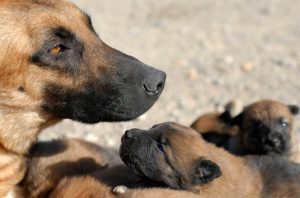

You may notice several changes in your dogs that can indicate that she is close to giving birth. Those include: an enlarged or dropped belly, enlarged nipples with the full teats, increased nervousness (pacing, panting) along with increased rest when she is not pacing.
When the mother starts nesting and displaying the above signs, you should start preparing for the birth. One of the more important items is a whelping box. The box should be big enough for the dog to be able to comfortably lay and stretch out in, but not be so big that the puppies can get lost in it. The side should be high enough to prevent the puppies from falling out but have an opening to allow the mother to get out. You should also have a heat lamp available, and placed outside the box, where the mother cannot touch it. Make sure that only one corner of the box has the heat lamp on it so that if the puppies get too warm, they have a cooler spot they can move to. Other items include towels/blankets, newspaper, alcohol and the number of your local emergency vet.
Labour in dogs consists of three phases:
Phase 1
This phase lasts between 4-24 hours and is when the cervix relaxes and dilates. You may see: restlessness, shivering, not eating, fast breathing, and maybe vomiting or diarrhea. These signs are related to the uterine contractions and hormonal changes occurring, but you should not see the mother straining at all. If this phase lasts longer than 24 hours, contact your vet immediately.
Phase 2
This phase is when the contractions come on quite strong, and there should be intense straining. The first pup should be born within an hour of this phase starting. If the mother strains for over an hour with no sight of a pup, please contact your vet. The time of delivery of the next puppy varies, but if the mother is straining for over 30 minutes with no sight of the second pup, you should contact your vet.
Phase 3
This phase involves the expulsion of the placentas. The mother should be relaxed, and the pups should be nursing. As dogs have multiple pups, there should be multiple placentas expelled. It is important to count the placentas as they come out and ensure that there is one placenta per pup, and it should be attached to the umbilical cords of the pups. When two puppies are born rapidly together, the placentas can come out together as well. If there are fewer placentas than there are puppies, there is a chance that the placenta was retained, and a vet needs to be contacted immediately. Prevent the mother from eating all the placentas, as it may cause her to start vomiting or have diarrhea.
You may notice that some puppies are born within the membrane. If this occurs, either the mother or you, the owner, need to break the sac and dry and clean the pup. Make sure the pup is breathing; usually the mother’s tongue can stimulate the pup to breathe. If this does not occur, you may need to assist them by clearing the throat or gently shaking them. You can try holding the puppy in the palm of your hand, head towards the fingers, and gently flick your wrists to expel any inhaled fluid. You can then massage the chest to stimulate breathing.
The mother also usually bites the umbilical cord. If she does not do this, you may need to tie them off and cut the cord on the placenta side of the tie.
Once the birth is over make sure the mother has plenty of water available and is in a warm and quiet spot. The pups should start nursing immediately, and the mother should be calm and happy. If you have any concerns regarding your dog, or if you think your dog is pregnant, please do not hesitate to contact Cronulla Vet Clinic on 02 9527 2604 with any questions.
Keep an eye out for our blog next month where we will talk about cats and the birthing process!
